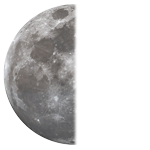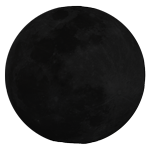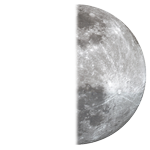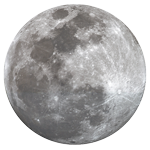
December 2025
Compiled by John Panek
Monthly Highlights
Refined measurements of the Cosmic Microwave Background shed new light on the Hubble Tension, the discrepancy in the Hubble constant representing the expansion rate of the universe. The Atacama Cosmology Telescope, closed in 2022, provided data confirming temperatures and polarizations at higher resolutions than and in agreement with data from the Planck observatory in L2 orbit. This "fossil light" from very early in the universe indicates a different Hubble constant than the value derived from Type 1a supernova light curves in the local universe. https://www.eurekalert.org/news-releases/1106637
A new synergistic ground-based technique for finding exoplanets (precision astrometry identifying candidates for high-contrast extreme adaptive optical imagers) has found a good target to test the upcoming Roman Space Telescope Coronagraph instrument. The OASIS instrument on the Subaru Telescope found 1) a superjovian orbiting the young A5 star HIP 54515 at 271 light years away and 2) a 60 Jupiter mass brown dwarf orbiting HIP 71618 at 169 light years away. This second find will be ideal for validating the RST/Coronagraph technologies that will eventually be used on Habitable Worlds Observatory. https://www.eurekalert.org/news-releases/1108450
Lightning caused by colliding dust particles has been detected on Mars! Only tens of centimeters long and caused by triboelectric effects, the discharges were recorded by microphones associated with Supercan on the Perseverance rover. Electromagnetic effects were also detected in the microphone circuitry in addition to the sounds of the discharges. https://www.nature.com/articles/s41586-025-09736-y
SCAS CELEBRATES
HONOR THE NIGHT
Ancient cultures measured time by the Moon's phases, the days of each cycle counted out. They knew when the Moon would wax and wane. Who today is aware whether the Moon is crescent, full or gibbous? We no longer honor the night sky. On a retreat with preteen students, far enough from city lights to see the cosmos, on a night when bright Venus cast a shadow, we asked them to turn off their flashlights, let their eyes adjust, Trust their steps in starlight. We honored the night sky.
Juliane Mc Adam, retired middle school language teacher, CA
Lunar Timetable
 Last Quarter December 11 3:51 pm
Last Quarter December 11 3:51 pm New Moon December 19 8:43 pm
New Moon December 19 8:43 pm  First Quarter December 27, 2:09 pm
First Quarter December 27, 2:09 pm Full Moon January 3, 5:02am
Full Moon January 3, 5:02amSOUTHERN CROSS OBSERVATION PAD
The popular free SOUTHERN CROSS OBSERVATION PAD HAS RE-OPENED in MIAMI-DADE BILL SADOWSKI Park! Come visit with us 7:30-10 p.m. Saturday's weather permitting. Bring `scopes & binocs, chairs, family, friends, colleagues, students, and bug repellent. Our SCAS Astros have introduced thousands to the awesome beauty of our seasonal night skies since 1986. Please dim headlights at the Park entrance SW 176 St./SW 79 Ave. 1/2 mile west of Old Cutler Road, Palmetto Bay 33157. The small parking lot is near the deck. Face masks are optional. Check the SCAS Facebook for weather/Holiday cancellations.
For astrophotography instruction visit our free D'AURIA outdoor observatory, Saturdays from dusk -10 P.M. 23325 SW 217 Avenue, Homestead 33031. Park outside the gate. No white lights, lanterns, lasers. litter, alcohol, or pets at both sites. For membership open www.scas.org
ENJOY SCAS PUBLIC STAR PARTIES: Weather permitting!
Saturday evenings dusk- 10 p.m.
SCAS Observation Pad in Miami-Dade Bill Sadowski Park SW 176 St./SW 79 Ave. Palmetto Bay 33157 free
D'Auria Observatory 23325 SW 217 Ave.dusk-10 p.m. astrophotograqphy information free No white lights, lanterns, lasers, litter, alcohol, or pets at either location.
METEOR SHOWERS THIS MONTH
GEMINIDS
Usually the strongest shower of the year, this occurrence promises great results with a moon rising near 2am local standard time the night of December 13/14. ZHR 150 (!)
Open the link: News and Information about Meteor Showers
Here are some tips on how to maximize your time looking for meteors and fireballs during any meteor shower:
- Get out of the city to a place where the city and artificial lights do not impede your viewing
- If you are out viewing the shower during its peak, you will not need any special equipment. You should be able to see the shower with your naked eyes.
- Carry a blanket or a comfortable chair with you - viewing meteors, just like any other kind of stargazing is a waiting game, and you need to be comfortable. Plus, you may not want to leave until you can't see the majestic celestial fireworks anymore.
In case you missed it......
The 41st annual Winter Star Party was a great success! Many sleep-deprived but happy astronomers report: BEST PARTY EVER!
Don't take my word for it, read the first hand accounts over on Cloudy Nights: https://www.cloudynights.com/topic/941985-winter-star-party-2025/page-3
BRIGHT COMETS THIS MONTH
Interstellar visitor 3I/ATLAS at around magnitude 11 is high in the morning twilight. https://www.cobs.si/comet/2643/
Fairly high in the evening twilight will be C/2025 T1 (ATLAS) at about magnitude 10 https://www.cobs.si/comet/2667/
SCAS HAM RADIO
Recently, member Dan Zuckerman replaced and upgraded his ham equipment. He was chatting with folks in Europe.
Do we have some retired, or new SCAS ham operators who would like to establish a SCAS radio dept?
It could become very convenient, or necessary in certain future conditions. Consider the astronomy information shared and maybe international SCAS members!
Contact Barb if you wish to link up with Dan. barbyager@aol.com.
SOLAR VIEWING
Weather permitting SCAS needs solar telescopes at the "front door" to ZooMiami 12400 SW 152nd st, starting this month
There will be large crowds of families. Please contact barbyager@aol.com ASAP if you can bring equipment, We are restoring our popular solarviewing events at ZooMiami.
Plans need to be made in advance. Updates will be sent out to members soon.
Interested to join our new solar team? Contact: barbyager@aol.com . If you have solar equipment or want to help, please send an email to Dr. Lester Shalloway with your information: drlester3@aol.com.
IN THE SKY
Jupiter rises a few hours after sunset in Gemini.
Saturn and Neptune spend the month just a few degrees apart high in the southern sky at sunset and set by midnight.
Mercury is splendid in the morning sky.
Venus and Mars are not visible this month, lost in the Sun's glare
NASA/SPACE NEWS
NASA's Astrobee Robots used electric fans and AI logic to navigate around the inside of the International Space Station. Testing them with minimal astronaut interaction, ground controllers directed trajectories with and without AI machine learning algorithms. Autonomous robots in the future will benefit from more efficient navigation without close supervision. https://www.space.com/space-exploration/international-space-station/ai-helps-pilot-free-flying-robot-around-the-international-space-station-for-1st-time-ever
ESA held its ministerial conference, setting the space agency's budget for the next three years at 22 billion euros. Some highlighted projects are early planning for an Enceladus lander mission and various launch vehicle developments. https://spacenews.com/esa-raises-more-than-22-billion-euros-at-ministerial/
Evening Sights
Jupiter rises in the east
Saturn high in the west
Orion and Gemini
Morning Sights
Mercury low in the east just before sunrise
ISS Passes